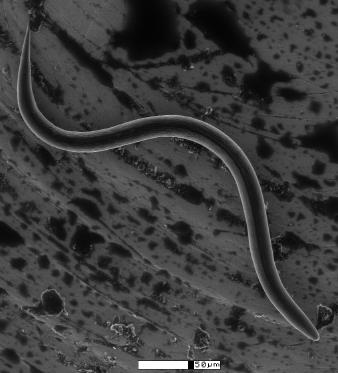Introduction to the "Aschelminth" Phyla


A very large and heterogeneous cluster of animals have traditionally been classified together in a group variously known as the Aschelminthes, Nemathelminthes, and/or Pseudocoelomata. Today, these organisms are classified in about ten separate phyla. Nonetheless, it is sometimes useful to retain the name "Aschelminthes" to cover all these organisms. Opinion is divided as to whether or not the aschelminth phyla form one monophyletic group. To make matters worse, different authors have not agreed on what phyla should be considered "aschelminths."
The most commonly recognized aschelminth phyla are:
So what, if anything, is an aschelminth? Most are soft-bodied worms, and many of them are microscopic -- in fact, practically all members of the Cycliophora, Gastrotricha, Kinorhyncha, Loricifera, and Rotifera are less than 1 millimeter long, as are many nematodes and priapulids. On the other hand, one species of parasitic nematode can reach 13 meters in length -- it parasitizes the sperm whale -- and adult nematomorphs, chaetognaths, and some priapulids are also visible to the naked eye.
Aschelminths used to be referred to as "pseudocoelomates" -- an alternative name for the taxon is Pseudocoelomata -- because of their supposed shared internal structure. True coelomates have a fluid-filled body cavity, the coelom, that surrounds the gut; this cavity exists within the middle tissue layer, the mesoderm, and the gut is suspended within it by sheets of tissue known as mesenteries. "Pseudocoelomates" may also have a body cavity around the gut; in some (e.g. the gastrotrichs) it is extremely small, while in others (e.g. nematodes and priapulids) it may be quite extensive. This cavity has traditionally not been considered a true coelom, because it supposedly does not exist within the mesoderm, true mesenteries are not present, and its development in the embryo is quite different. However, this dichotomy between "coelomates" and "pseudocoelomates" appears to be false. A full discussion of this issue is beyond the scope of this exhibit; suffice it to say that some traditional "coelomates" and some traditional "pseudocoelomates" do not fit their traditional definitions. Body cavities develop in several different ways and perform many different functions within the animal kingdom.
A number of aschelminths are parasitic, including the Acanthocephala, which parasitize vertebrates; the Nematomorpha, which parasitize insects and other arthropods; and the Nematoda, which include parasites of plants and animals as well as many non-parasitic, free-living species. Free-living, microscopic "aschelminths" may be extremely common in moist soils and fresh-water sediments (gastrotrichs, rotifers and nematodes). Others may abound in marine sands and muds (gastrotrichs, kinorhynchs, loriciferans, nematodes, priapulids, rotifers). The arrowworms, found in marine waters, are generally planktonic and can swim; they are voracious predators on other planktonic organisms. Many small aschelminths, in particular many rotifers and nematodes, are able to suspend their life processes completely when conditions become unfavorable; in these resistant states they can survive extreme drying, heat, or cold, and then return to life when favorable conditions return. This is known as cryptobiosis.
Since aschelminths all lack substantial hard parts, their fossil record is extremely spotty. Most of the microscopic phyla have no known fossil record at all, and seem unlikely ever to be found as recognizable fossils. The Rotifera are only known as far back as the Oligocene. Fossil nematodes are occasionally found in amber (fossilized tree resin) from the Cenozoic, but possible fossil nematodes have been found in older rocks of the middle Paleozoic. The oldest known "aschelminth" phylum is the Priapulida. These unsegmented worms have been found in Cambrian rocks, such as the legendary Burgess Shale. Priapulids, at least, date from the earliest known evolutionary radiation of the animals, and a few trace fossils suggest that nematodes may have been around at the time as well. Evidence from the anatomy and genetic information of living "aschelminths" suggest that the aschelminth phyla are much older than their sparse fossils would indicate. However, no consensus has yet been reached as to how these phyla evolved and how they are related to each other.
Resources for specific taxa include:

